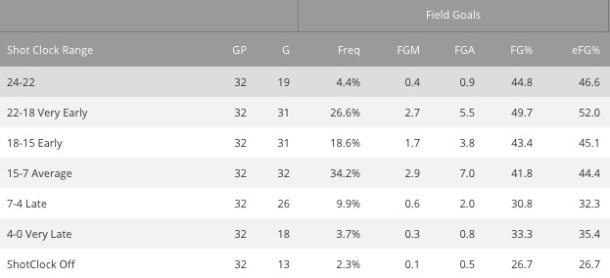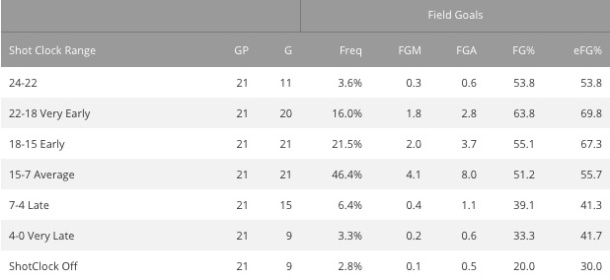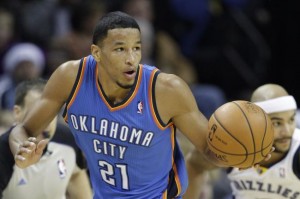
 How do you measure the value of a bad shot that wasn’t taken?
How do you measure the value of a bad shot that wasn’t taken?
In the NBA, where flash outweighs substance to the common fan, it’s proven to be an exceedingly difficult proposition.
And that’s the easiest way to explain why Andre Roberson of the Oklahoma City Thunder has struggled to find consistent minutes on the most star-studded team in the NBA. Glutted into a rotation with three other offensive-minded wings — Dion Waiters, Reggie Jackson and Anthony Morrow — Roberson has consistently sat on the end of the bench in the fourth quarter due to his perceived offensive deficiencies.
To be fair, those individual offensive deficiencies are obvious to see. He’s shooting just 21.3% from deep on the season, and that’s after a week in which he made five of six attempts. His 3.8 points per game won’t impress you nor will his 47.6 free throw percentage (or occasionally horrific airball). Simply put, Roberson’s not a shooter. He played power forward in college and, until he measured at just 6-foot-6 at the NBA combine, he planned to play power forward in the NBA. Now there’s cruel positional irony as he carves out a career as a nominal “shooting guard,” making him look like the weak link in a loaded Thunder starting lineup.
Despite being a starter, Roberson has logged the fewest minutes of the four Thunder off-ball guards since the new year.
This may be a little hard to swallow for those who put points at a premium: In spite of his offensive deficiencies, in the context of the Thunder’s personnel, Roberson has actually proved to be Oklahoma City’s most valuable perimeter player not named Kevin Durant or Russell Westbrook on both sides of the ball.
How, you ask? His defense is simply so good that it creates free offense for his teammates. When Roberson is on the court, the Thunder allow just 101.1 points per 100 possessions. That’s the best individual defensive rating on the team and would make OKC the second best defense in the league behind the Warriors if they kept up that pace for 48 minutes. However, once Roberson sits, Oklahoma City’s defense regresses to allow 105.3 points per 100 possessions. Those extra 4.2 points allowed per 100 possessions slide Oklahoma City from the second best to the 12th best defense in the league.
Herein lies a common misconception about basketball: you don’t necessarily need to have offensive skills to be a valuable player toward your team’s offense. If you assumed that Roberson’s defensive contributions were negated on the other side by his limited offense, you wouldn’t be alone. But you’d also be wrong.
When Roberson plays, Oklahoma City scores 106.7 points per 100 offensive possessions. That’s not an incredible clip, but it’s good enough to tie them with Sacramento and Utah for the 14th best offense in the league. When Roberson sits and is replaced by one of OKC’s three offensive-minded wings, Dion Waiters, Anthony Morrow and Reggie Jackson, the Thunder’s offense slides to just 103.5 points per 100 possessions — a mark on par with the Knicks for 23rd best in the league.
The explanation for his positive offense has two folds. Primarily, Roberson’s defense is so good that he single handedly creates fast break opportunities for his team several times per game.
Oklahoma City’s offense is predicated on pushing the tempo. Westbrook and Durant are two of the best offensive transition players in the league and thrive on finding shots early in the shot clock to rack up easy points. Observe each player’s shot dashboard and notice how each player’s field goal percentage and effective field goal percentage diminish as the shot clock winds down.
Westbrook:
Durant:
When Westbrook and Durant stop getting those easy looks in transition, the team’s offensive becomes a predictable mess of isolation ball in the half court. OKC attempts the seventh most pull-up field goals in the league (per NBA.com/stats) with 23.1 per game. They make 38% of those pull-ups, which is actually a fairly decent mark in comparison to most other teams, mostly due to their talent. However, these pull-ups are the hallmark of stagnant offensive sets — like this pull-up from Waiters from Wednesday’s game against the Knicks:
[youtube https://www.youtube.com/watch?v=nxI1hBd_C5Q]
The team’s entire efficiency declines as they take longer against the shot clock:
Simply put: when opponents are making shots, the Thunder have to inbound the ball which gives the opponents just a sliver of extra time to get back and defend in transition. This increases the likelihood that Oklahoma City’s possession will end in a forced pull-up.
However, when opponents are missing shots or turning the ball over, those miscues turn into quick transition opportunities for OKC on offense.
Watch in the video below how clearly Roberson creates free offense for OKC simply by being active defensively:
[youtube https://www.youtube.com/watch?v=AgS8cEbqCi8]
That’s the most obvious example of Roberson’s defense leading to offense. However, the examples go far beyond the clean breakaway steals for himself.
The second branch of Roberson’s offensive value stems from his understanding of his offensive deficiencies. Once he gets the steal or rebound, he knows to get the ball out of his hands and push the pace for Westbrook and Durant. Here’s another obvious example of Roberson’s defense turning into Thunder offense:
[youtube https://www.youtube.com/watch?v=Wo2XkUp732g]
Roberson’s metrics rank him among the best defensive players in the league. He places among the NBA’s top three shooting guards in defensive Real Plus Minus and makes a significant impact in altering opponents’ shots: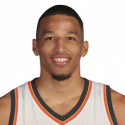
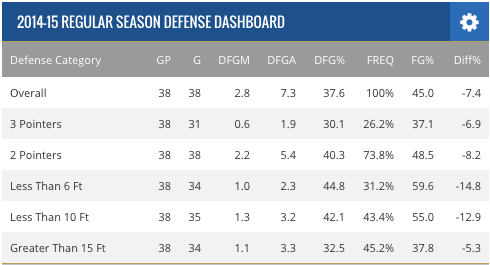
What this chart explains is that the NBA average player shoots 45% overall from the field. However, when Roberson is defending, the average NBA player’s field goal percentage drops to 37.6%. That -7.4% impact for Roberson’s defense ranks him among the best perimeter defenders in the league. For comparison’s sake, All-NBA defender Tony Allen of Memphis has a -6.8% defensive impact.
“Defense is one of my strong suits and I’m taking advantage of it right now,” Roberson told SheridanHoops. “I’m going out there competing every night and giving it my all. That’s what coach asks for me to do, to lock up the opponent’s best offensive player and go out there and give it my all. I’m not about the stats so much.”
Roberson’s long, quick and good with his hands. There’s rarely space to get a clean look when he defends. He’s become a master at fighting through screens. The clip below is against Kyle Korver, the most dangerous offensive player without the ball in the entire league. Roberson is screened twice on the play but recovers in milliseconds to force Korver into an uncomfortable pass and eventual turnover.
[youtube https://www.youtube.com/watch?v=P6cSywnunzQ]
In comparison to Roberson’s competitors for minutes, it’s clear why his elite defense is so valuable. Simply put, Waiters, Jackson and Morrow are bad defenders.
For as much talk as there’s been about Waiters’ newfound attention to detail defensively with OKC, it hasn’t amounted to anything of substance on the court. If you exclude the first five games of the hooneymoon period between Waiters and the Thunder and count just his past five games, Waiters’ Defensive Field Goal Percentage is 46.8%, slightly worse than league average. But that only measures his individual defense. In a team defensive setting, Waiters’ defense is a target for opposing offenses. Waiters’ rotations have been late and his protection of the driving lane has been uninspring, as he allows 65.3% on shots within 6 feet. That’s about 20% worse than Roberson.
Jackson and Morrow aren’t any better than Waiters. They both allow approximately 70% of opponents shots within 6 feet. Roberson’s 44.8 Defensive Field Goal Percentage within 6 feet ranks him among the league’s best wing players at helping protect the hoop.
And perhaps that’s where Roberson is most valuable to the Thunder. His willingness to slide over in defensive rotations both limits opponent penetration but also positions himself well for defensive rebounds, where he’s excellent. Roberson rebounds approximately 11% of all missed shots that occur while he’s on the court. That’s on par with Lance Stephenson for the best rate among starting shooting guards in the NBA. (It also ranks him ahead of stars such as Carmelo Anthony and LeBron James.)
Watch here as Roberson is not only smart about positioning his body in the help defense to prevent a bailout pass from the baseline but is also scrappy enough to rip the ball from Al Jefferson on the rebound:
[youtube https://www.youtube.com/watch?v=o90sYDNGwE0]
Notice how once he grabs the rebound, he’s immediately looking to push the tempo. Roberson knows his value on offensive is predicated on creating fast breaks. While Roberson’s individual offensive skills demonstrably lag behind Waiters, Jackson and Morrow, he simply doesn’t take shot opportunities away from Westbrook and Durant — which inherently makes him more valuable to the team’s offense. Roberson averages only 3.2 shots per game on 25 touches of the ball per game.
“We’ve got two of the best offensive players in the game and you know, I’m just trying to give them an opportunity to go out there and show [people] why,” Roberson explained. “I don’t want to take anything away from them. I mean, sometimes I have to go out there and take a couple of my own. I do shoot the ball when I’m open.”
Roberson understands that if he refuses to shoot, he will hurt his team’s spacing. As a result, he’s tinkered with his shot through his two-year career and is starting to show tangible progress. He’s made 10 of his last 15 shots, including five of his last six from deep.
“We just like that he’s gaining confidence,” Kevin Durant told SheridanHoops. “He’s going to keep taking them when he’s open and they’re leaving him open. We trust in Andre.”
If Roberson does develop into even a league-average shooter at some point down the road, he will become one of the league’s very best role players. He just turned 23 years old in December. He’s not close to his peak. Elite defense combined with adequate shooting and low usage is a rare commodity in this league and is a perfect compliment for a team with Westbrook and Durant.
“I’ve switched up my shot a bit since I’ve gotten here,” Roberson admits. “I’m just trying to come along and stick with the process and put in the hard work. It’s paying off.”
One thing working for Roberson is his work ethic. He’s earned teammates’ respect for hours logged at the gym.
“He works hard, man,” Serge Ibaka said. “His hard work is paying off. We trust in him. When he’s open we pass him the ball. He means a lot for us on offense and defense.”
While the rest of league might not recognize it, Ibaka is exactly right: Roberson’s is the unsung secret to Oklahoma City’s arsenal.
Jacob Eisenberg is a college senior at Emory University and covers the NBA for SheridanHoops.com. Follow him on Twitter and check out his website.
MORE FROM EISENBERG:
KYLE KORVER TO BROOKLYN WAS IN THE BAG UNTIL FERRY INTERVENED
SECRET BEHIND JIMMY BUTLER’S EVOLUTION
IS ANTHONY DAVIS BETTER THAN KEVIN GARNETT? THROUGH TWO SEASONS, YES


